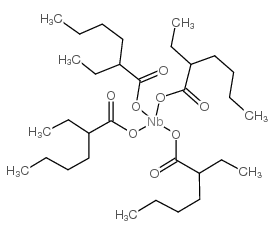2-ethylhexanoate,niobium(5+)
Modify Date: 2024-01-31 00:22:16

2-ethylhexanoate,niobium(5+) structure
|
Common Name | 2-ethylhexanoate,niobium(5+) | ||
|---|---|---|---|---|
| CAS Number | 206564-87-6 | Molecular Weight | 665.72000 | |
| Density | N/A | Boiling Point | N/A | |
| Molecular Formula | C32H60NbO8 | Melting Point | N/A | |
| MSDS | N/A | Flash Point | N/A | |
| Name | 2-ethylhexanoate,niobium(5+) |
|---|---|
| Synonym | More Synonyms |
| Molecular Formula | C32H60NbO8 |
|---|---|
| Molecular Weight | 665.72000 |
| Exact Mass | 665.33500 |
| PSA | 105.20000 |
| LogP | 8.84120 |
|
Section 1: Product Identification Chemical Name:Niobium (IV) 2-ethylhexanoate CAS Registry Number:206564-87-6 Formula:Nb[OOCCH(C2H5)C4H9]4 EINECS Number:none Chemical Family:metal carboxylate Synonym:2-Ethylhexanoic acid, niobium salt
Section 2: Composition and Information on Ingredients IngredientCAS NumberPercentACGIH (TWA)OSHA (PEL) Title Compound206564-87-680%no datano data 2-Ethylhexanoic acid149-57-520%no datano data Section 3: Hazards Identification Emergency Overview:Irritating to the respiratory tract, skin and eyes. May be harmful if swallowed. Primary Routes of Exposure:Eye, ingestion Eye Contact:Causes severe irritation of the eyes. Skin Contact:Causes slight to mild irritation of the skin. The product is a viscous liquid with essentially no vapor pressure at room temperature. Inhalation is not a Inhalation: route of exposure. Ingestion may lead to behavioral changes, somnolence, reproductive effects, weight loss, stomach upset, and Ingestion: vomiting. Acute Health Affects:Irritating to skin, eyes and respiratory tract. Chronic Health Affects:No information available on long term chromic effects. NTP:No IARC:No OSHA:No SECTION 4: First Aid Measures Immediately flush the eyes with copious amounts of water for at least 10-15 minutes. A victim will need Eye Exposure: assistance in keeping their eye lids open. Get immediate medical attention. Wash the affected area immediately with water. Remove contaminated clothing if necessary. Seek medical Skin Exposure: assistance if irritation persists. Remove the victim to fresh air. Closely monitor the victim for signs of respiratory problems, such as difficulty Inhalation: in breathing, coughing, wheezing, or pain. In such cases seek immediate medical assistance. Seek medical attention immediately. Keep the victim calm. Give the victim water (only if conscious). Induce Ingestion: vomiting if directed by medical personnel. SECTION 5: Fire Fighting Measures Flash Point:>230°F Autoignition Temperature:not determined Explosion Limits:not determined Extinguishing Medium:dry chemical, carbon dioxide, water spray or foam. If this material is involved in a fire, fire fighters should be equipped with a NIOSH-approved positive pressure Special Fire Fighting Procedures: self-contained breathing and full protective clothing. Hazardous Combustion andcarbon dioxide, carbon monoxide, soot, and organic byproducts. Decomposion Products: Unusual Fire or Explosion Hazards: No unusual fire or explosion hazards. SECTION 6: Accidental Release Measures Spill and Leak Procedures:Small spills can be absorbed into vermiculite or other suitable adsorbent. SECTION 7: Handling and Storage Store in a cool, dry, well-ventilated area away from heat and direct sunlight. Keep containers tightly sealed. Handling and Storage: Material is moisture sensitive. SECTION 8: Exposure Controls and Personal Protection Always wear safety glasses. If pouring or transferring this substance wear a face shield for additional Eye Protection: protection. Skin Protection:Wear protective clothing and gloves. Consult with glove manufacturer to determine the proper type of glove. Ventilation:Work with this product in a well-ventilated area, preferably a fume hood. If ventilation is not available a respirator should be worn. The use of respirators requires a Respirator Respirator: Protection Program to be in compliance with 29 CFR 1910.134 Ventilation:Work with this product in a well-ventilated area, preferably a fume hood. Additional Protection:No additional protection required. SECTION 9: Physical and Chemical Properties Color and Form:yellow, viscous liquid Molecular Weight:665.73 Melting Point:no data Boiling Point:no data Vapor Pressure:no data Specific Gravity:no data Odor:none Solubility in Water:insoluble in water SECTION 10: Stability and Reactivity Stability:moisture sensitive Hazardous Polymerization:no hazardous polymerization Conditions to Avoid:none Incompatibility:Strong oxidizing agents Decomposition Products:carbon dioxide, carbon monoxide, niobium oxide and organic fumes. SECTION 11: Toxicological Information No specific information available on the niobium compound. For 2-ethylhexanoic acid: Skin (rabbit); 450mg (mild reaction). Eye (rabbit); 20mg (severe reaction). Oral (rat); LD50: 3gm/kg. Inhalation (rat); LC: RTECS Data: >400ppm/6H. Skin (rabbit); LD50: 1200uL/kg. Oral (rat); TDLo: 25200mg/kg/3W-C. See RTECS #M07700000 for additional information. Carcinogenic Effects:No reported carcinogenic effects Mutagenic Effects:No reported mutagenic effects Tetratogenic Effects:No reported Teratogenic effects SECTION 12: Ecological Information Ecological Information:No information available SECTION 13: Disposal Considerations Dispose of according to local, state and federal regulations. For purposes of shipping waste material see the Disposal: section 14 in this document on transportation. SECTION 14: Transportation Shipping Name (CFR):Non-hazardous Hazard Class (CFR):NA Additional Hazard Class (CFR):NA Packaging Group (CFR):NA UN ID Number (CFR):NA Shipping Name (IATA):Non-hazardous Hazard Class (IATA):NA Additional Hazard Class (IATA):NA Packaging Group (IATA):NA UN ID Number (IATA):NA SECTION 15: Regulatory Information TSCA:Title Compound - not listed SARA (Title 313):not regulated by Title 313 Second Ingredient:TSCA - listed SECTION 16 - ADDITIONAL INFORMATION N/A |
| Risk Phrases | R36/37/38 |
|---|---|
| Safety Phrases | 26-36/37/39 |
| Hexanoic acid,2-ethyl-,niobium salt (1:) |
| Niobium 2-ethylhexanoate |
| Hexanoicacid,2-ethyl-,niobium salt (9CI) |